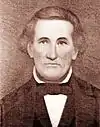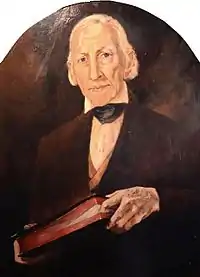Acht Zeugen
Die Acht Zeugen sind im Mormonismus eine von zwei Gruppen von Zeugen, welche eine Erklärung abgaben, dass sie die goldenen Platten gesehen haben, die laut Joseph Smith die Quelle für das Buch Mormon sein sollen. Die andere Gruppe sind die drei Zeugen mit den Namen Oliver Cowdery, Martin Harris und David Whitmer.



Zeugnis

Das Zeugnis der acht Zeugen wurde zuerst am Ende der Auflage von 1830 des Buches Mormon veröffentlicht und wurde dann in alle späteren Auflagen übernommen, obwohl die Erklärung später an den Anfang des Buches verschoben wurde und grammatikalisch korrigiert wurde.
Im Gegensatz zu den drei Zeugen sollen die acht die Platten gesehen und in ihren Händen gehalten haben.[1]
Umstände
Nach der Lehre der Mormonen beendete Joseph Smith Ende Juni 1829 seine Übersetzung des Buches Mormon (mit Oliver Cowdery als seinem Schreiber) und bekam eine Offenbarung, die im Buch Mormon steht, das „drei“ und „einige andere“ die Goldplatten sehen werden.[2] Danach hatten die drei Zeugen ihr Erlebnis und später die acht Zeugen.[2]
Über die Zeugen
Die acht Zeugen waren alle Mitglieder der Smith- oder Whitmer-Familien. Joseph Smith senior war sein Vater, Hyrum und Samuel waren seine Brüder. Christian, Jacob, Peter Jr. und John waren die Brüder von David Whitmer und Hiriam Page war sein Stiefbruder.[3]
Trennung von Smith
Im Jahre 1838 gab es einen Machtkampf in der Kirche; alle Mitglieder der Whitmer-Familie wurden exkommuniziert und bekamen ein Ultimatum von den Daniten.[4] Nach dem Tod von Smith folgte keiner der Whitmer-Familie Brigham Young und der Gruppe, die später die Kirche Jesu Christi der Heiligen der Letzten Tage werden würde.
Obwohl die Whitmer-Familie sich von Smith trennte, gibt es keine Beweise, dass je ein Zeuge sein Zeugnis widerrief über die Authentizität des Buches Mormon und der Goldplatten.[5]
Weitere Literatur
Einzelnachweise
- According to Terryl Givens, Joseph invited the Eight "to a family prayer spot in the woods" and "matter-of-factly displayed to them the golden plates," whereas the Three were shown the plates "by an angel of God [who] came down from heaven." Terryl Givens, By the Hand of Mormon (Oxford University Press, 2002), 40.
- Gale Yancey Anderson: Eleven Witnesses Behold the Plates. In: Journal of Mormon History. Band 38, Nr. 2, 2012.
- Richard Lyman Bushman, Joseph Smith: Rough Stone Rolling (New York: Alfred A. Knopf, 2005), S . 79: "Critics pointed out how many of the witnesses were members of the Smith and Whitmer families, implying that they signed out of loyalty or from a self-serving motive .... The witnesses were no substitute for making the plates accessible to anyone for examination, but the testimonies showed Joseph—and God—answering doubters with concrete evidence, a concession to the needs of post-Enlightenment Christians."
- Bushman, 337, 339, 350–51. On June 17, Sidney Rigdon "preached a vitriolic sermon based on the theme of salt losing its savor and being cast out and trodden underfoot .... Soon after the sermon, eighty-three prominent members in Far West, many of them probably Danites by then, signed an ultimatum demanding the departure of the offenders .... Fearing for their property and perhaps their lives, the dissenters fled." (355–51) In 1847, David, John, and Jacob Whitmer and Hiram Page were baptized into the newly formed Church of Christ (Whitmerite) founded by William E. M'Lellin. In 1831, Joseph Smith received a revelation from God that John Whitmer should "write and keep a regular history" of the church (D&C 47). Whitmer did eventually write such a history, but one which concluded with a detailed description of what Whitmer considered the mistreatment that he and his family had received in Caldwell County. See Bruce N. Westerngren, From Historian to Dissident: The Book of John Whitmer (Salt Lake City: Signature Books, 1995).
- Terryl Givens: The Book of Mormon: A Very Short Introduction. Oxford University Press, 2009, S. 99.;. One third-hand source, the former Mormon leader Stephen Burnett, said in 1838 that Martin Harris had told him that "the eight witnesses never saw [the plates] & hesitated to sign that instrument for that reason, but were persuaded to do it." Stephen Burnett letter to Lyman E. Johnson dated April 15, 1838. Typed transcript from Joseph Smith Papers, Letter book, April 20, 1837 – February 9, 1843, microfilm reel 2, S. 64–66, LDS Church archives

